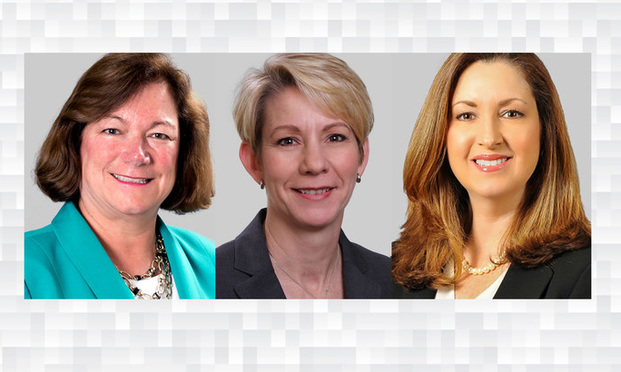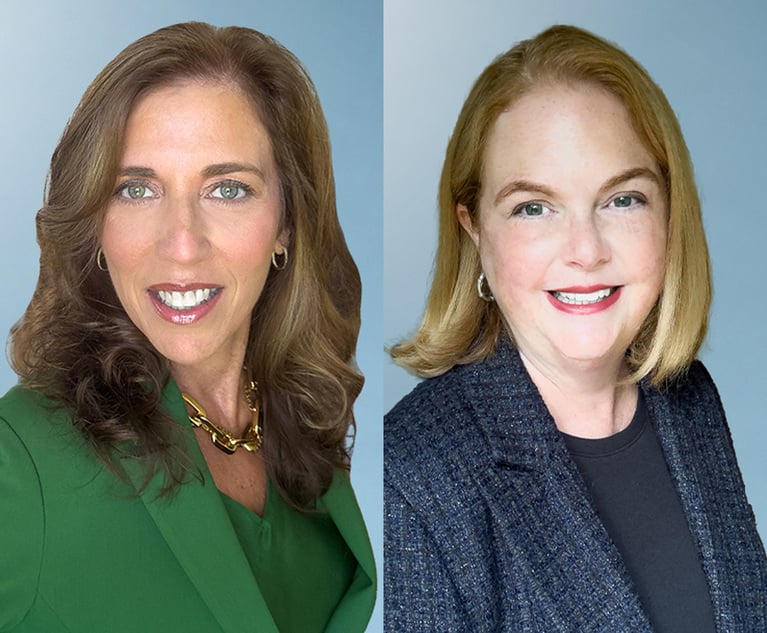Interested in a State's Pay Equity Laws? Check Out This Firm's Interactive Map
Employment firm Fisher Phillips has launched an interactive map that details pay equity laws in all 50 states.
February 23, 2018 at 04:23 PM
3 minute read
 (L-to-R) Kathleen Caminiti, Cheryl Pinarchick, and Janet Hendrick.
(L-to-R) Kathleen Caminiti, Cheryl Pinarchick, and Janet Hendrick.
With the #MeToo and #TimesUp movements gaining force and bringing attention to gender pay equality, employment firm Fisher Phillips has launched an interactive map detailing pay equity laws in each of the country's 50 states.
Following a soft opening this month, the Pay Equity Interactive Map , which can be found on Fisher Phillips' website, went live on Feb. 22
“The purpose of it is to be able to provide employers with an understanding of the pay equity law and landscape across the country,” said Kathleen Caminiti, a partner in New Jersey and New York who is a co-chair of the firm's pay equity practice group.
The firm has 32 offices across the country.
Caminiti said states have become more active in enacting laws dealing with pay equity, and that is information employers need.
“Many states have existing laws on their books prohibiting discrimination based on gender and those include pay disparity. But a good many states are enacting more robust legislation…such as a provision to ban salary history inquiries,” she said.
Caminiti said the time has come for employers to look closely at pay equity—an issue most recently brought to the public's attention at the Golden Globes awards in January, when actresses spoke out about pay inequality. Also, Caminiti said she has seen an “explosion” of pay equity litigation, with suits targeting white-collar professions such as law and accounting, as well as industries such as pharmaceuticals.
“As a matter of social consciousness, a lot of companies are taking a pledge to evaluate pay and eliminate pay disparities,” she said. “It's a movement that's been in the making for 50 years. It seems that now is the time the area of pay equity is a hot topic and we expect it to continue.”
Cheryl Pinarchick, another co-chair of the pay equity practice group at Fisher Philips, said there is such a patchwork of state and even local laws on pay equity that lawyers have to work hard just to keep up with them all.
“If we as a firm are struggling to do this, what must our clients be feeling and thinking?” Pinarchick said.
Because the law is evolving so rapidly, clients are “frustrated and completely challenged to make sure they are in compliance,” said Dallas-based partner Janet Hendrick, who is also a partner in the pay equity practice group.
Hendrick said the map, which is available to the public, is a valuable tool for clients. But it also serves a dual role—helping with business development.
“Its [purpose is] really to show our clients our expertise in this area,” she said. “[But] hopefully they will look at the page of our practice group…and see what kind of services we can offer.”
This content has been archived. It is available through our partners, LexisNexis® and Bloomberg Law.
To view this content, please continue to their sites.
Not a Lexis Subscriber?
Subscribe Now
Not a Bloomberg Law Subscriber?
Subscribe Now
NOT FOR REPRINT
© 2025 ALM Global, LLC, All Rights Reserved. Request academic re-use from www.copyright.com. All other uses, submit a request to [email protected]. For more information visit Asset & Logo Licensing.
You Might Like
View All
Once the LA Fires Are Extinguished, Expect the Litigation to Unfold for Years
5 minute read

Faegre Drinker Adds Three Former Federal Prosecutors From Greenberg Traurig
4 minute read
Anapol Weiss Acquires Boutique Led by Star Litigator Alexandra Walsh
5 minute readTrending Stories
- 1Family Court 2024 Roundup: Part I
- 2In-House Lawyers Are Focused on Employment and Cybersecurity Disputes, But Looking Out for Conflict Over AI
- 3A Simple 'Trial Lawyer' Goes to the Supreme Court
- 4Clifford Chance Adds Skadden Rainmaker in London
- 5Latham, Kirkland and Paul Weiss Climb UK M&A Rankings
Who Got The Work
J. Brugh Lower of Gibbons has entered an appearance for industrial equipment supplier Devco Corporation in a pending trademark infringement lawsuit. The suit, accusing the defendant of selling knock-off Graco products, was filed Dec. 18 in New Jersey District Court by Rivkin Radler on behalf of Graco Inc. and Graco Minnesota. The case, assigned to U.S. District Judge Zahid N. Quraishi, is 3:24-cv-11294, Graco Inc. et al v. Devco Corporation.
Who Got The Work
Rebecca Maller-Stein and Kent A. Yalowitz of Arnold & Porter Kaye Scholer have entered their appearances for Hanaco Venture Capital and its executives, Lior Prosor and David Frankel, in a pending securities lawsuit. The action, filed on Dec. 24 in New York Southern District Court by Zell, Aron & Co. on behalf of Goldeneye Advisors, accuses the defendants of negligently and fraudulently managing the plaintiff's $1 million investment. The case, assigned to U.S. District Judge Vernon S. Broderick, is 1:24-cv-09918, Goldeneye Advisors, LLC v. Hanaco Venture Capital, Ltd. et al.
Who Got The Work
Attorneys from A&O Shearman has stepped in as defense counsel for Toronto-Dominion Bank and other defendants in a pending securities class action. The suit, filed Dec. 11 in New York Southern District Court by Bleichmar Fonti & Auld, accuses the defendants of concealing the bank's 'pervasive' deficiencies in regards to its compliance with the Bank Secrecy Act and the quality of its anti-money laundering controls. The case, assigned to U.S. District Judge Arun Subramanian, is 1:24-cv-09445, Gonzalez v. The Toronto-Dominion Bank et al.
Who Got The Work
Crown Castle International, a Pennsylvania company providing shared communications infrastructure, has turned to Luke D. Wolf of Gordon Rees Scully Mansukhani to fend off a pending breach-of-contract lawsuit. The court action, filed Nov. 25 in Michigan Eastern District Court by Hooper Hathaway PC on behalf of The Town Residences LLC, accuses Crown Castle of failing to transfer approximately $30,000 in utility payments from T-Mobile in breach of a roof-top lease and assignment agreement. The case, assigned to U.S. District Judge Susan K. Declercq, is 2:24-cv-13131, The Town Residences LLC v. T-Mobile US, Inc. et al.
Who Got The Work
Wilfred P. Coronato and Daniel M. Schwartz of McCarter & English have stepped in as defense counsel to Electrolux Home Products Inc. in a pending product liability lawsuit. The court action, filed Nov. 26 in New York Eastern District Court by Poulos Lopiccolo PC and Nagel Rice LLP on behalf of David Stern, alleges that the defendant's refrigerators’ drawers and shelving repeatedly break and fall apart within months after purchase. The case, assigned to U.S. District Judge Joan M. Azrack, is 2:24-cv-08204, Stern v. Electrolux Home Products, Inc.
Featured Firms
Law Offices of Gary Martin Hays & Associates, P.C.
(470) 294-1674
Law Offices of Mark E. Salomone
(857) 444-6468
Smith & Hassler
(713) 739-1250






